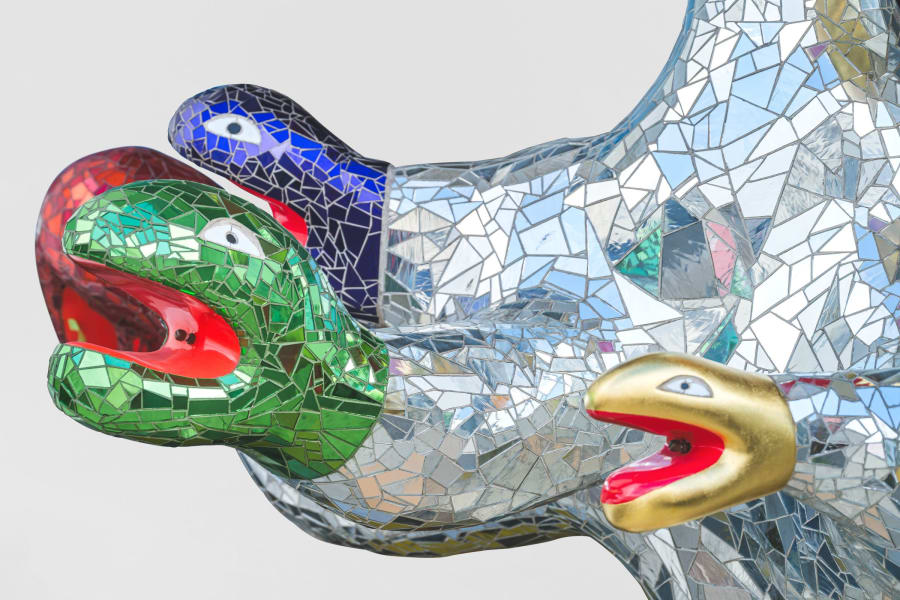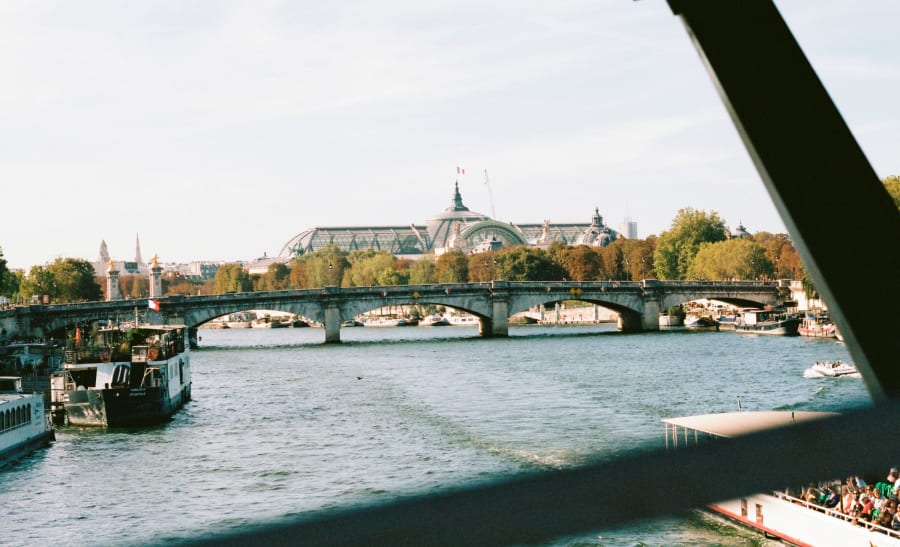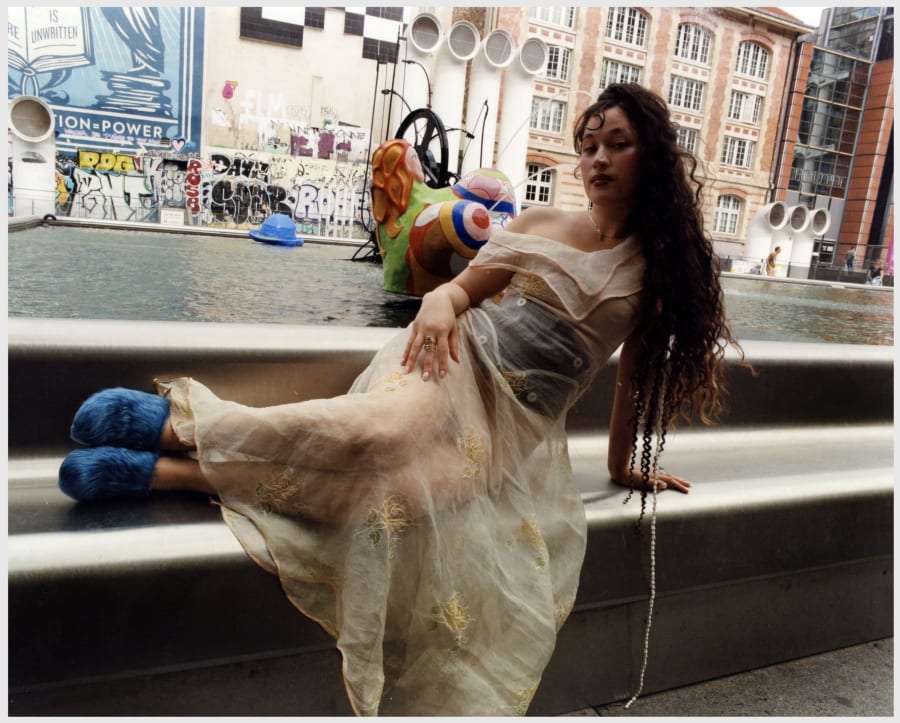What should everyone have in their bag when visiting an art fair?
Aileen Agopian: An iPhone, one extra charger, and definitely mints.
Sabrina Buell: I wear a small cross-body bag. It’s the Art Olympics and you don’t want to carry unnecessary weight all day. In it is my phone, which I use to take pictures of the works I acquire for my clients. I always have a fair map circled with galleries and works of interest noted.
What would you recommend to those visiting Art Basel Paris for the first time?
AA: The true value of attending an art fair in person lies in the opportunity to cultivate relationships with gallerists. A fair like Art Basel Paris offers the ease of connecting with a multitude of galleries from around the world, all under one roof. While the primary focus is to build your art collection and educate your eye, it’s equally important to have conversations that extend beyond the pieces exhibited at the fair. These relationships and discussions often bear fruit in the form of valuable insights into future artist projects, upcoming museum exhibitions, and new talents that gallerists may introduce to you. If you consider working with an art advisor to start your art collecting journey, I recommend exploring the Association of Professional Art Advisors (APAA); it’s a fantastic resource to discover expert art advisors all over the world.
SB: Plan to have four full days, especially in Paris, which probably has the most to offer culturally of almost any city. One or two full days for the fair, with a proper lunch to break up the days in the middle; one full day to see galleries, which are spread out all over the city; and a full day or two for the museums. Ideally, you can do galleries and museums in the days before the fair, so that when you arrive at Art Basel Paris on Wednesday, you have gotten your eye mileage and your eyes are trained to look for works that speak to you most strongly.
Which artists and galleries are you most looking forward to discovering at the 2024 edition?
AA: I’m eagerly anticipating the majestic beauty of the Grand Palais and exploring all three sections of the fair. From conversations with respected dealers and collectors, it’s clear that Art Basel Paris has become a major draw for international collectors, institutions, and art connoisseurs. In response, galleries will offer high-caliber artwork by primary and secondary artists. As discretion is integral to my clients, I’m politely refraining from disclosing any artist names, but there are many!
SB: Air de Paris is one of my favorite French galleries and I’m looking forward to what they present. In the Emergence sector, I’ll go straight to Madragoa, the coolest young gallery in Lisbon, where I live on and off. In the main sector, I hope to connect with LambdaLambdaLambda, a gallery from Kosovo that I don’t yet know but have heard is great. I always look forward to discovering young artists at Commonwealth and Council, and works by South American artists at Fortes D’Aloia & Gabriel.
Which galleries and museums are you most looking forward to visiting in the city?
AA: I adore wandering through the Marais to see incredible shows at some of my favorite galleries, and I am especially excited to see Nohemí Pérez’s work at mor charpentier’s new space. I’m also looking forward to experiencing the work of Barbara Chase-Riboud throughout Paris’s prominent museums, from the Louvre, Musée D’Orsay, Pompidou, and Palais de Tokyo to the many other institutions that celebrate her work in dialogue with their own collections. At the Pompidou, I will definitely see the ‘Surréalisme’ show which celebrates the 100th anniversary of the founding Surrealist Manifesto text by André Breton. You can find me lingering over the extraordinary work of many female Surrealists like Leonora Carrington, Dorothea Tanning, and Remedios Varo.
SB: Paris has so much to offer outside the fair. I can’t wait for the Olga de Amaral exhibition at Fondation Cartier, and to see Julian Charrière’s ‘Stone Speakers’ at Palais de Tokyo. A San Francisco gallerist I love, Micki Meng, is opening her new space in Paris, so I’ll go there right away. I never miss a trip to Chantal Crousel, no matter what they are showing, and it’s been so fantastic to have galleries like White Cube, Stuart Shave, and Mendes Wood open beautiful spaces in Paris.
What are the most important factors when selecting artworks for a client? Are there any differences when dealing with clients in the US versus Europe?
AA: My role is to understand each client’s unique preferences – the artists that resonate with them – and help refine and expand their interests. Yet it’s equally important to encourage discovery and occasionally challenge perceptions by introducing artists or works they may not have previously considered. Whether acquiring primary or secondary market works, or whether the artist is established, mid-career, or emerging, it is crucial to thoroughly understand their market. This also includes evaluating the condition, provenance, and exhibition history of a piece. Ultimately, the goal is to ensure that each acquisition fits meaningfully within the artist’s broader oeuvre while aligning with market dynamics.
SB: When you’re at a fair, you come up against a lot of considerations. It could be a great artist, but not their best work. It could be a great work, but at the wrong price. It could be the right price, but not ideal condition, and so on. We try to sort through all these issues ahead of the fair so that when we get there our clients have all the answers to make an informed choice. Always at the top of the list is the question ‘Does this speak to you? Do you love it?’ We haven’t found a difference in dealing with clients in the US versus Europe – only that European clients get stopped in the halls more often to have very polite hellos with their friends.
What’s your advice on how best to discover the fair and the Public Program?
AA: As an advisor, I receive the majority of gallery offerings weeks prior to the fair. While pre-planning is crucial to my objective of securing the highest caliber and most compelling works for my clients, it’s essential during the fair to leave room for discovery. The immediacy and visceral impact of experiencing a new artist or seeing a work in the flesh that captivates you is truly invaluable. Some of my most memorable discoveries arise from breaking away from my typical algorithm. On a practical note, make sure to download the Art Basel app, which has extensive information about the fair and programming. Additionally, an app like See Saw keeps you abreast of all the shows happening around Paris.
SB: Start out by visiting the smaller galleries and the perimeters or the upstairs of the fair. During the first few hours, it can be quieter in these areas, and you can have conversations with the gallerists that are more meaningful. Some booths can seem strange and unfamiliar but remember that these younger galleries have been carefully vetted by the Art Basel Selection Committee and represent the best in the world. Making it into an Art Basel fair is a huge deal and they are putting their best foot forward, so digging a little deeper can be very rewarding. After lunch, go see the bigger galleries in the center. By that time, they have cleared up the reserves and morning business and are usually a little more accessible to engage. And don’t forget what a great resource the Art Basel website can be! Time spent on it ahead of the fair will tell you so much about the museum shows not to miss in the city and the great speakers who will be in dialogue during the fair.
Could you share a secret of your profession?
AA: My secret is straightforward: I choose to work with clients whom I respect and value both professionally and personally – individuals who share a deep passion and drive for art and knowledge, a commitment to building collections of enduring value, and a preference for discretion. I’m fortunate to collaborate with an extraordinary group of different clients who inspire, challenge, and trust me, and we have a great deal of fun doing it, which is key!
SB: At Zlot Buell + Associates, our secret superpower is that we are known for honesty and integrity across the board. I suppose the not-so-secret secret is that this is not always the case in the art world. A good way to find trusted advisors is to look for members of the APAA.
After the fair, where do you stop for a drink or dinner with your clients?
AA: Dinner is often decided by invitations from galleries, which is always a treat. But we love to have cocktails at Cravan and the full experience of Ogata, a gourmet Japanese restaurant.
SB: At Le Voltaire, Quai Voltaire, or Loulou Restaurant, Rue de Rivoli.
What’s your hidden gem in Paris?
AA: I’m a bibliophile at heart and I love spending time in the oval room of the National Library of France’s Richelieu location. It was beautifully renovated after being under construction for several years, and thankfully now it’s open to the public. It’s a magical place to let your mind wander.
SB: I am coffee obsessed and love going to Dreamin Man for a pour-over.
Aileen Agopian is a member of APAA (Association of Professional Art Advisors). She is based in New York.
Sabrina Buell is a member of APAA (Association of Professional Art Advisors). She is based in San Franscisco.
Art Basel Paris will take place at the Grand Palais from October 18 to 20, 2024. Learn more here.
Caption for top image: View of Fortes d’Aloia and Gabriel’s booth at Art Basel in Basel 2024.
Published on October 3, 2024.


